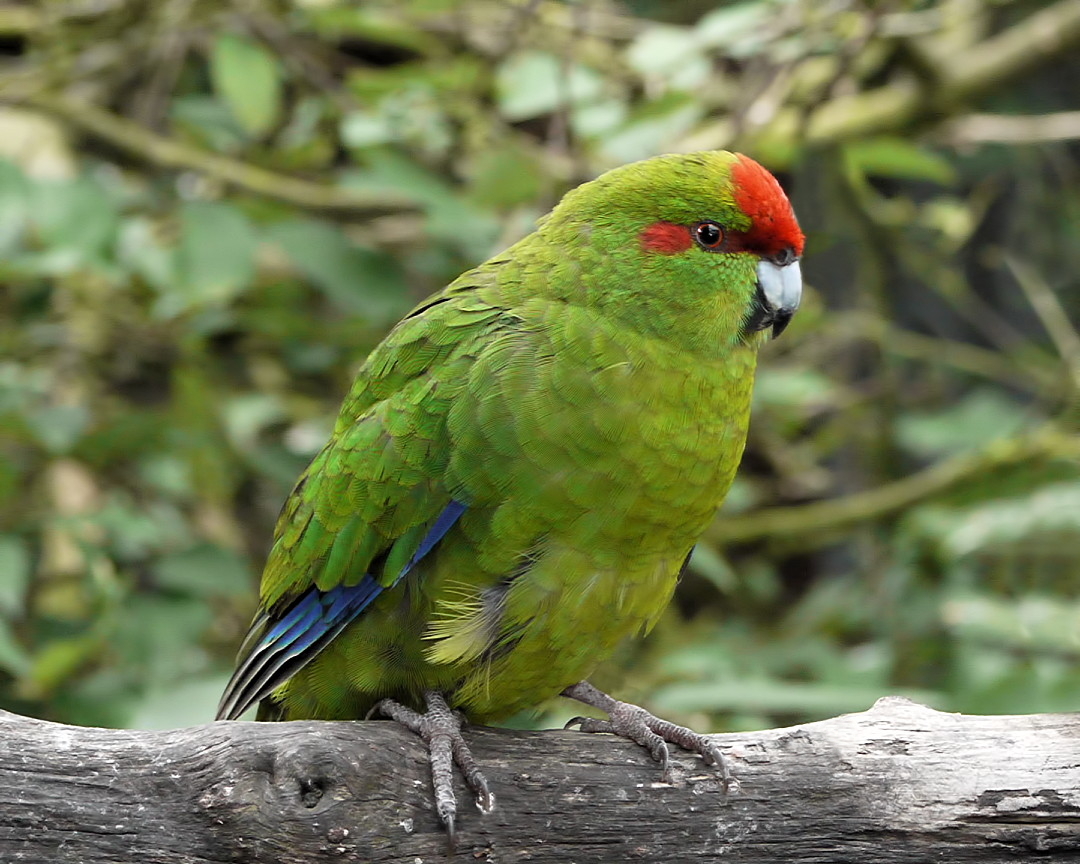
Red-crowned parakeet, orRed-fronted parakeet, orNew Zealand parakeet(Cyanoramphus novoezelandiae)
Phylum —chordata
Class — aves
Order — psittaciformes
Family —psittaculidae
Genus – cyanoramphus
Appearance
Red-crowned parakeets are green parrots with large tails. They are easiest to identify by their bright yellow-green plumage, and crimson forehead, lores, eye-stripes and front of the crown. They also have red patches on either sides of the rump. While they are flying, their dark blue outerwing can be visible. Red-crowned parakeets have grey or pale brown legs and feet. Their bills are white to grey with a black tip.Females are slightly smaller with a yellow stripe on the underwing. Their bill is also smaller and narrower.
The adults reach an average length of 11 inches (27 centimeters) and can weigh up to 4 ounces (113 grams).
Habitat
Formerly common throughout New Zealand, red-crowned parakeets are now largely restricted to pest-free offshore and outlying islands, from the Kermadec Islands east to the Chatham Islands and south to the Auckland Islands.
Behavior
Red-crowned parakeets have colonized and adapted to a range of environments and habitats on islands from the tropics to the subantarctic. Despite their rather erratic flight they are strong fliers and readily move within island groups searching for seasonal foods. When environmental conditions are good they are able to breed quickly, leading to rapid increases in population size. Red-crowned parakeets often forage for food on the ground or within low shrubby vegetation, making them vulnerable to ground-hunting predators.
Diet
Red-crowned parakeets are highly generalized and diverse when it comes to feeding. They consume flowers, fruits, seeds, leaves and buds from a variety of plants. They also complement their diet with a few invertebrates such as small aphids and can be fed mealworms. Their feeding habits vary throughout the year depending on the seasonal availability of food. In winter and spring, the birds mostly eat flowers. In summer and autumn, their main food items consist of seeds
Reproduction
Red-crowned parakeets have been recorded breeding year round, with the main breeding period subject to regional variations. They are cavity-nesters, preferring hollows in trees but also using holes in the ground, in cliff faces, talus slopes and under dense vegetation. The average clutch size for the nominate subspecies is 7 (range 4 to 9). Female parakeets are responsible for all nest preparation, incubation, brooding and feeding of chicks until 10-14 days of age, with all food provided to her by her mate. Thereafter, male and female parakeets feed chicks at the nest until fledging and independence. Egg-laying takes several days to complete, with incubation usually commencing after the second egg is laid. Incubation takes approximately 23 days, and the chicks hatch asynchronously, so there is a large variation in chick size within a brood. Nestling period varies widely depending on hatch order (nestling period 32-49 days). The last chicks to hatch usually fledge at an earlier age and are less developed than their older siblings. More than one brood may be attempted if the initial nest fails or if food supply allows.
In captivity
The Red-fronted parakeets don't have a very long lifespan, 10 to 15 years, but they are nonetheless hardy and healthy birds.
Keep in mind that these are parrots with a lot of energy and a great love of flying. You will need to give them plenty of room to ensure optimal health. Free flight around the house is encouraged and will create a deeper bond between you and your little pet.
For your pet, a commercial small parrot seed mix will work best. To give them a necessary supplement of calcium, experts recommend a cuttlebone. They also come in a form of a perch – it acts as a toy and an important supplement at the same time.
Red-crowned parakeets LOVE baths. You can fill up your sink with a few centimeters of water and offer your sparky pet a well-deserved bath. The way they flap their wings and go nuts in a bath will leave you laughing.
 Russian
Russian
 English
English























